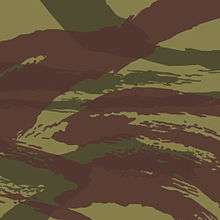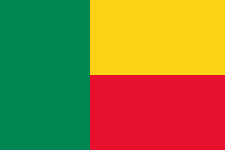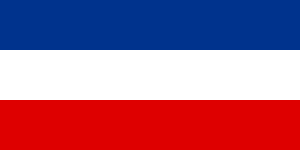Lizard (camouflage)

The Lizard pattern (TAP47 pattern or Leopard pattern for the French) is a kind of military camouflage pattern used by the French Army on uniforms from 1947 to the late 1980s.[1]
The Lizard pattern and its descendants
A lizard pattern has two overlapping prints, generally green and brown, printed with gaps so that a third dyed color, such as a lighter green or khaki, makes up a large part of the pattern. In this, it is printed like earlier British patterns used on that country's Paratroopers Denison smocks. Lizard patterns have narrower printed areas than the British patterns, and have a strong horizontal orientation, cutting across the vertical form of a man's body.
Other patterns descend in turn from Lizard patterns, either by direct imitation such as Cuba's Lizard pattern, or innovation, such as the tigerstripe patterns produced during the Vietnam War. Tigerstripe patterns (French experimental development during the Indochina war which was based on the TAP47 pattern and which became the South Vietnamese Marines pattern) differed from Lizard patterns in that their printed areas are interlocked rather than overlapped, and they use smaller areas of dyed background color.
Users
-
 Afghanistan: Northern Alliance
Afghanistan: Northern Alliance -
 Algeria
Algeria -
 Angola
Angola -
 Armenia
Armenia -
 Australia
Australia -
 Benin
Benin -
 Brazil
Brazil -
 Cameroon
Cameroon -
 Cape Verde
Cape Verde -
 Chad
Chad -
 China
China -
 Comoros
Comoros -
 Croatia
Croatia -
 Cuba
Cuba -
 Cyprus
Cyprus -
 Djibouti
Djibouti -
 Egypt
Egypt -
 France
France -
 Gabon
Gabon -
 Greece
Greece -
 India
India -
 Iraq
Iraq -
 Israel
Israel -
 Ivory Coast
Ivory Coast -
 Kenya
Kenya -
 Lebanon
Lebanon -
 Libya
Libya -
 Malaysia
Malaysia -
 Mauritania
Mauritania -
 Montenegro
Montenegro -
 Morocco
Morocco -
 Mozambique
Mozambique -
 Namibia
Namibia -
 Portugal
Portugal -
 Russia
Russia -
 Senegal
Senegal -
 Serbia and Montenegro
Serbia and Montenegro -
 Serbia
Serbia -
 Singapore
Singapore -
 South Africa: 32 Battalion ("Buffalo Battalion")
South Africa: 32 Battalion ("Buffalo Battalion") -
 South Vietnam
South Vietnam -
 Sudan
Sudan -
 Syria
Syria -
 Timor-Leste
Timor-Leste -
 Turkey
Turkey -
 Togo
Togo -
 Uganda
Uganda -
 Vietnam (in 1979)
Vietnam (in 1979) -
 Yugoslavia
Yugoslavia
See also
References
- ↑ Kamouflage.net: 1953 French 'lizard' pattern http://www.kamouflage.net/camouflage/00104.php
